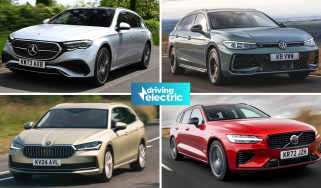Volkswagen Passat GTE Estate review
The Passat GTE plug-in hybrid estate offers comfort, space and appealingly low running costs – especially for company-car users
Pros
- Useful electric range
- Good to drive
- Spacious
Cons
- Rivals more practical
- Gearbox occasionally slow
- Less economical when battery drained
| Car type | Electric range | Fuel economy | CO2 emissions |
|---|---|---|---|
| Plug-in hybrid | 37 miles | 235mpg | 27-28g/km |
The Passat GTE Estate returned to Volkswagen’s line-up in 2020 with several improvements over its predecessor. Among them was a new 13kWh battery that increased the plug-in hybrid estate's official electric driving range up to 37 miles and its fuel economy to 235mpg.
It was a major improvement helping the Passat stay competitive with rivals such as the BMW 330e Touring, Volvo V60 Recharge, Mercedes C-Class hybrid and other models from the VW Group, such as the Skoda Superb iV Estate. Production of the four-door Passat saloon ceased in early 2022, so the only option left, for the plug-in GTE or otherwise, is the estate version.
Power is supplied by a smooth-revving 1.4-litre turbocharged petrol engine and one electric motor. Together they produce a combined output of 215bhp which is sent through a six-speed automatic transmission. That means a 0-62mph time of 7.6 seconds and a top speed of 138mph.
From behind the wheel, the Passat GTE seems to do it all: it’s good to drive, spacious, practical and reasonably well equipped. LED lights, alloy wheels, DAB digital radio, sat nav, leather seats and blue ambient interior lighting are standard, while the top-of-the-range GTE Advance jumps from 17 to 18-inch alloys and adds LED matrix headlights, voice control, keyless entry and a powered tailgate.
The Passat GTE comes with some decent safety kit as well, with Volkswagen's ‘Travel Assist’ package including adaptive cruise control and lane-keeping assistance. The semi-autonomous technology can automatically adjust your speed when the speed limit changes, and can also use GPS data to slow down for corners, roundabouts and junctions.
Wireless Apple CarPlay and Android Auto smartphone connectivity is included, too, along with blue brake calipers, C-shaped LED daytime running lights and an eight-inch infotainment touchscreen: the GTE Advance model adds a 9.2-inch touchscreen and a larger digital display to boot.
The GTE Estate emits 27 to 28g/km of CO2 (larger-wheeled cars are slightly more polluting). That means a Benefit-in-Kind rating of 12%, which is likely to attract company-car users, with the promise of low running costs only strengthening the GTE’s case. The plug-in wagon’s 235mpg fuel economy figure is equally impressive, but as is the case with all plug-ins achieving this in the real world depends on regular charging.
Naturally, the Passat GTE Estate is a practical car, however the boot shrinks from 650 to 483 litres compared to the non-hybrid models in the line-up, due to the 13kWh battery. Underfloor storage is useful for keeping cables, there’s no load lip and the rear seats drop easily thanks to quick-release flaps in the boot.
Inside, there’s masses of room for passengers; even tall adults won’t be left wanting for head or legroom, although the fifth passenger in the middle-rear seat might not be too happy on longer trips. As a family car, there are few better packages than that provided by the GTE Estate, although buyers have to make peace with the fact that the pure petrol and diesel models can carry more gear. For more on the Volkswagen Passat GTE Estate, read on for the rest of our in-depth review...




